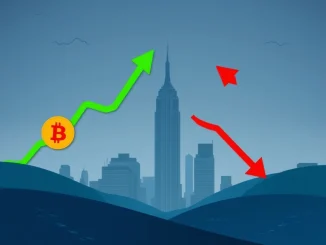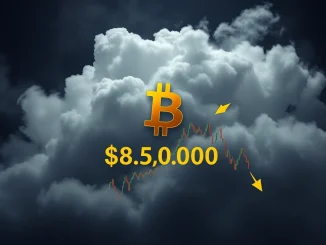
Are you tracking the pulse of the Bitcoin market? If so, you might have noticed something interesting happening with trading activity on centralized exchanges. A significant shift in BTC volume could be hinting at what’s next for the leading cryptocurrency.
What’s Happening with Bitcoin Volume?
Recent analysis from CryptoQuant analyst Axel Adler Jr. sheds light on a notable trend: average weekly Bitcoin (BTC) trading volumes on centralized exchanges (CEXs) have seen a dramatic decrease. This isn’t a small dip; the volume has fallen sharply since the market turbulence following the collapse of the Terra (LUNA) ecosystem in mid-2022.
- July 2022 Volume: Approximately 2.9 million BTC traded weekly on average.
- Current Volume (as of analysis date): Roughly 426,000 BTC traded weekly on average.
- The Scale of the Drop: This represents a reduction of over 85% in average weekly CEX trading volume.
This substantial decline in crypto exchange activity is a key data point that analysts are watching closely. It raises questions about market participation, liquidity, and what it might mean for future price movements.
Could Lower BTC Volume Be Bullish?
Counterintuitively, a sharp drop in trading volume, particularly on exchanges, can sometimes be interpreted as a bullish signal, especially when viewed in a long-term context. Axel Adler Jr. suggests this is precisely the case here. His reasoning centers on the concept of supply and demand dynamics.
Think about it this way:
- Reduced Selling Pressure: Lower volume on exchanges can indicate that fewer participants are actively selling their Bitcoin. This doesn’t necessarily mean no one is selling, but the *rate* and *quantity* of BTC being moved onto exchanges for immediate sale might be lower.
- Accumulation Phase: A period of low volume after a significant price movement (or a turbulent event like the LUNA crash) can sometimes signal a phase of accumulation. Long-term holders or institutions might be acquiring Bitcoin off-exchange or gradually accumulating without causing large price swings that high volume trading often entails.
- Lower Available Supply on Exchanges: If less BTC is flowing onto exchanges and being actively traded, the readily available supply for buyers decreases. In a market where demand eventually picks up, a restricted supply on exchanges can lead to rapid price increases as buyers compete for limited coins. This impacts the overall BTC price dynamic.
This perspective aligns with a view that significant amounts of Bitcoin might be moving into cold storage or less liquid environments, reducing the potential selling pressure that active exchange trading represents.
Interpreting the Market Analysis
While the drop in BTC volume is a clear statistical observation, its interpretation as a bullish signal requires careful consideration within the broader market analysis context.
Benefits of This Interpretation:
- Provides a potential long-term bullish framework despite current price consolidation or volatility.
- Highlights a shift in market structure away from speculative, high-frequency trading towards potential longer-term holding.
- Offers a fundamental reason (supply dynamics) why future price rallies could be sharper if demand returns.
Challenges and Nuances:
- Where Did the Volume Go?: Some volume might have shifted to decentralized exchanges (DEXs) or over-the-counter (OTC) desks, although CEXs historically dominate spot volume.
- Market Sentiment: Low volume can also indicate a lack of interest or indecision in the market, which isn’t inherently bullish on its own.
- Correlation vs. Causation: The correlation between low volume and subsequent price rallies has been observed historically, but it’s not a guaranteed outcome. Other macroeconomic factors and crypto-specific news events play significant roles in the BTC price.
Actionable Insights for Investors
What does this analysis mean for you as an investor or trader?
Understanding the trend in crypto exchange volume is crucial for forming a complete picture of market health. While low volume doesn’t guarantee an imminent price surge, it can be one piece of the puzzle suggesting underlying accumulation rather than distribution.
- Observe Long-Term Trends: Focus on sustained volume trends rather than daily fluctuations. The sharp drop highlighted by CryptoQuant is a significant long-term shift.
- Combine Indicators: Don’t rely solely on volume. Look at other on-chain data (like exchange reserves, HODLer behavior) and traditional technical indicators.
- Consider Your Strategy: If you believe in the long-term bullish case, periods of low volume and price consolidation might present accumulation opportunities, assuming your overall market analysis supports it.
- Manage Risk: Regardless of bullish signals, the crypto market remains volatile. Always invest based on your risk tolerance and investment horizon.
Conclusion: A Quiet Accumulation Phase?
The significant decline in average weekly BTC volume on centralized exchanges since 2022, as pointed out by CryptoQuant, is a compelling data point. While low volume can sometimes signal market apathy, in this context, following a major shakeout, it could indeed be interpreted as a sign of reduced selling pressure and potential long-term accumulation.
This period of lower activity on exchanges might be setting the stage for future price appreciation by limiting the readily available supply when demand eventually increases. However, like all market analysis, it’s essential to view this trend as one factor among many influencing the future direction of the BTC price. Keeping an eye on volume alongside other on-chain and macroeconomic indicators will be key to navigating the market ahead.



